Introduction
Commercial due diligence is a critical process that goes beyond financial audits to thoroughly examine the various aspects of a business. It involves assessing everything from environmental compliance and IT infrastructure integrity to legal and tax obligations. This comprehensive scrutiny enables investors to make well-informed decisions by identifying potential risks.
The process also involves evaluating market positioning, customer base, competitors, suppliers, and regulatory landscape to align investments with market opportunities. Recent developments in commercial real estate and the current fundraising climate highlight the dynamic nature of due diligence and the need for professionals with in-depth knowledge. By meticulously following key steps such as data preparation, technology and product analysis, market positioning, assessment of legal and regulatory risks, and vision and impact evaluation, businesses can present a compelling case to investors.
Company X's successful approach to streamlining the due diligence process and their focus on objectives, scope, leveraging technology, collaboration, and cross-functional teams serve as best practices for maximizing efficiency. Ultimately, commercial due diligence minimizes risks, enables informed decision-making, and enhances value creation in mergers and acquisitions.
Understanding Commercial Due Diligence
Commercial due diligence is a multifaceted process that examines the many layers of a business beyond the balance sheet. This rigorous analysis delves into the health and viability of a company's operations, touching on critical areas such as environmental compliance, IT infrastructure integrity, and legal and tax obligations. It involves scrutinizing financial statements, assets, liabilities, cash flows, and future projections, as well as assessing the company's positioning in relation to market trends, customer base, competitors, suppliers, and the regulatory landscape.
Such comprehensive scrutiny is crucial, as it identifies potential risks and enables investors to make well-informed decisions.
For instance, the case of an options-based market project underlines the importance of determining the originality of the code and whether it's a modified fork, along with identifying the primary functions used by consumers. Similarly, understanding the risks and evaluating safety measures, particularly in industries like utilities, where regulatory compliance and public reputation are paramount, can significantly impact investment decisions.
Recent developments in commercial real estate demonstrate the dynamic nature of due diligence. As sectors like office space navigate transitions similar to the retail disruptions a decade ago, investors must adapt their strategies. The office market, while challenged, shows signs of revival, with newer constructions since 2015 experiencing positive absorption and a slowdown in the pipeline, indicating potential for selective investment.
In the current fundraising climate, which mirrors the uncertainty of 2021, firms are increasingly seeking professionals with in-depth product knowledge and sales operations expertise to refine their strategies and focus on the most lucrative revenue streams. This trend underscores the importance of due diligence in aligning a firm's investments with market opportunities and capital availability.
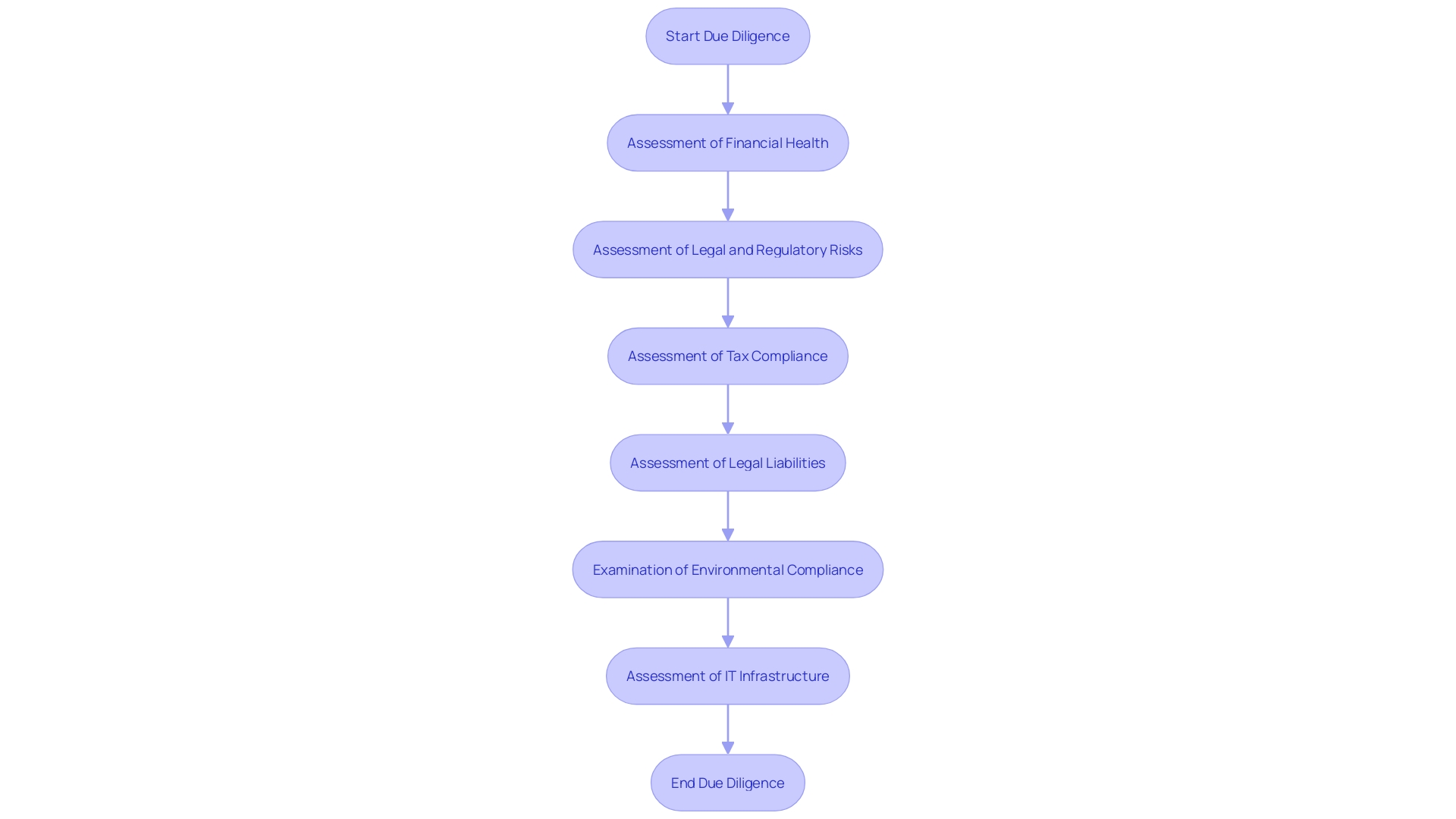
Case Study: Streamlining the Commercial Due Diligence Process
Company X, a major player in the global market, refined its commercial due diligence to enhance their mergers and acquisitions (M&A) strategy. They focused on recognizing the essential stakeholders of the target company, including joint venture partners and founders, to ensure a comprehensive understanding of the value and risks involved. This approach is crucial in M&A activities, as it helps in identifying and negotiating terms regarding the existing partnerships and stakeholder rights, a strategy echoed by M&A experts like Christian Atzler.
During the due diligence phase, Company X also prioritized staying abreast of the latest trends and research in supply chain management. This step was vital in understanding the potential for sustainable practices and efficiency in the target's operations, akin to the efforts made by companies such as Rivian in their commitment to environmental sustainability and net zero emissions.
In addition to these strategic efforts, Company X's due diligence process was supported by cutting-edge technology. Similar to the alliance between Bovill and KRM22, which utilized advanced technology to tackle market abuse surveillance, or AI Clearing's use of artificial intelligence to track construction progress, Company X leveraged technological solutions to ensure a robust and efficient M&A process.
Throughout the due diligence, Company X was guided by key performance indicators (KPIs), sustainability of business practices, customer risk assessment, and an understanding of the business's seasonality. Their approach mirrored the comprehensive commercialization strategies used in sectors like medical device manufacturing, emphasizing the importance of a clear regulatory path and supply chain strategy.
Mergers and acquisitions are intricate, with contracts that are among the most complex in financial markets. Company X's attention to detail and structured approach in their due diligence process is a testament to the importance of these contracts, as highlighted by extensive research on M&A agreements spanning over two decades.
Ultimately, Company X's due diligence process was not just a perfunctory step but an integral part of their strategy, as they aimed to minimize risks, identify key value drivers, and maximize M&A efficiency—goals that are shared by industry leaders who continually strive to innovate and adapt in the dynamic global market.
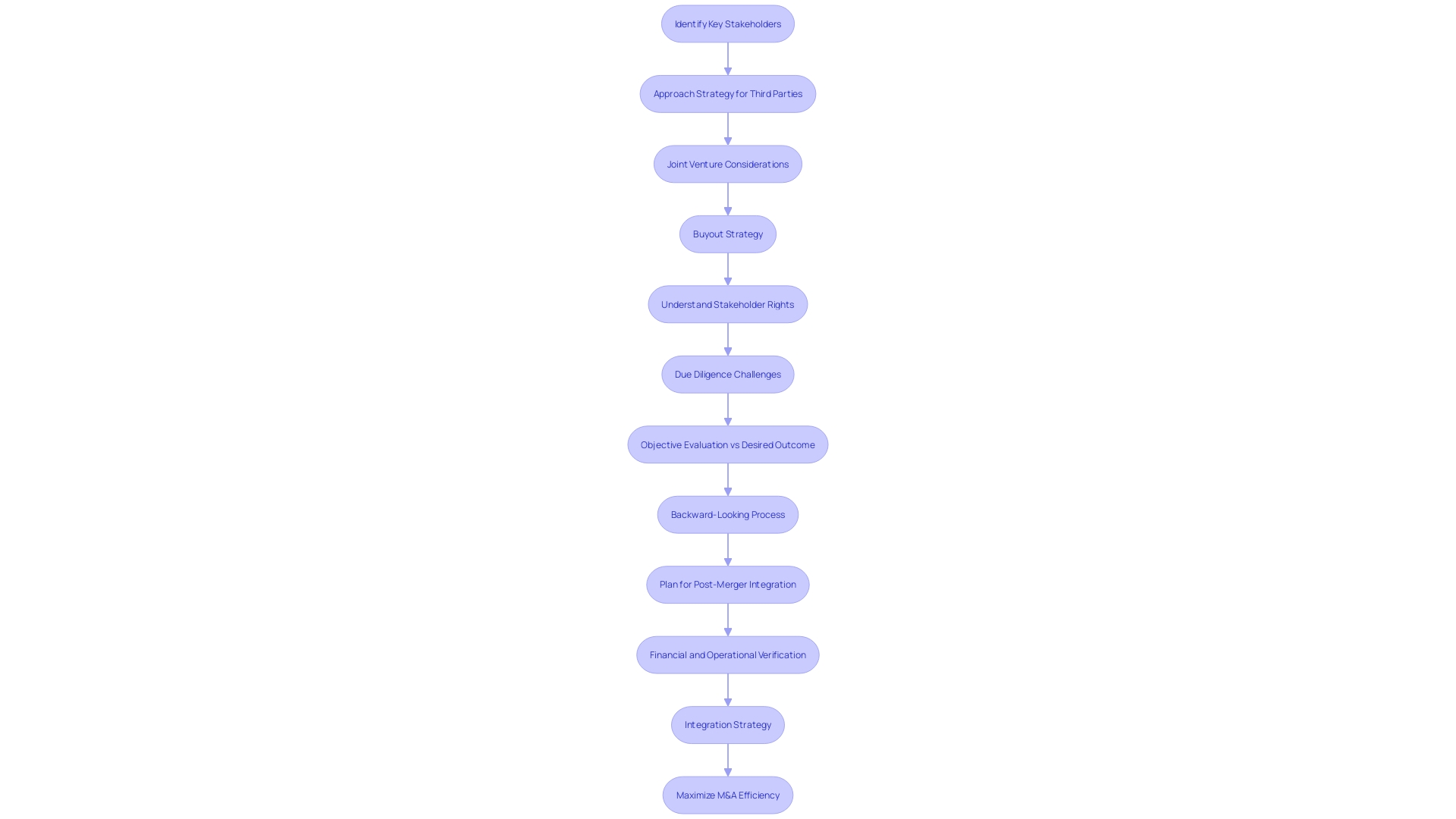
Key Steps in the Commercial Due Diligence Process
The commercial due diligence process is a comprehensive investigation that serves as a critical foundation for any successful investment or acquisition. To navigate this complex process effectively, let's dissect the pivotal steps that have been instrumental for companies in maximizing their due diligence efficiency.
-
Data Preparation: This initial phase is devoted to compiling and analyzing financial materials, customer data, and business models. It's a period where companies like GrowthPoint intensely scrutinize their clients' businesses to anticipate potential investor or acquirer queries. Financial statements, assets, liabilities, cash flows, and projections are put under the microscope to ensure a thorough understanding of the company’s financial health.
-
Technology and Product Analysis: A deep dive into the technological framework and product offerings is crucial. Companies assess whether the code is original or a derivative (fork) and if it's been modified to serve the unique aspects of the business. This gives investors confidence in the distinctiveness and market fit of the products.
-
Market Positioning: Understanding the competitive landscape is non-negotiable. Companies must demonstrate a solid grasp of their position in the market, how they differentiate from competitors, and show evidence of consumer demand. The statement, 'no competition exists,' is often a red flag for investors, highlighting a possible oversight in market analysis.
-
Assessment of Legal and Regulatory Risks: Due diligence extends beyond financial audits to include a full examination of legal compliances, regulatory risks, tax law adherence, and any legal liabilities through partnerships or licensing agreements. This thorough evaluation is particularly vital in heavily-regulated industries.
-
Vision and Impact: Starting with the end in mind, companies outline who they are aiding, the impact of their product, and the core values they bring. The product's vision, projected sales, supply chain's role in success, and key milestones are all articulated to align with potential investors' interests.
By meticulously following these steps, businesses can present a compelling case to investors and acquirers, underpinned by a robust due diligence process that addresses each critical aspect of their operations and market potential.
Defining Objectives and Scope
Company X meticulously approached the due diligence process by setting precise objectives and defining its scope. The focus was on crucial elements such as market analysis, customer segmentation, competitive landscape, and regulatory compliance. This strategic planning was essential for a streamlined, effective due diligence phase.
Due diligence transcends a mere financial audit; it's an in-depth examination of a company's varied facets. Regulatory compliance, financial health—including statements, assets, debts, cash flows, and projections—and legal liabilities are carefully scrutinized. For industries with stringent regulations, understanding legal and regulatory risks is paramount, just as ensuring tax law compliance is critical through the review of tax returns, audits, and agreements.
A holistic view of due diligence considers not only the technical and financial aspects but also cultural compatibility. For instance, Schippers, co-founder of HappyFunCorp, emphasizes the importance of cultural fit and communication plans during M&A. This underscores the need for a cultural integration strategy that acknowledges and leverages the unique strengths of both entities involved.
In the rapidly evolving business environment, companies like Toyota's Woven Planet have faced challenges due to ambitious software projects that did not align with concrete car-launch schedules. This highlights the importance of a due diligence process that is not only thorough but also adaptable to the dynamic nature of technology and market demands.
Furthermore, the financial sector's increasing reliance on data-driven decision-making aids market growth, as evidenced by a 2022 S&P Global survey showing a significant shift towards data-informed choices. Such insights underline the importance of a comprehensive due diligence process that ensures informed, evidence-based decisions for successful business operations and investments.
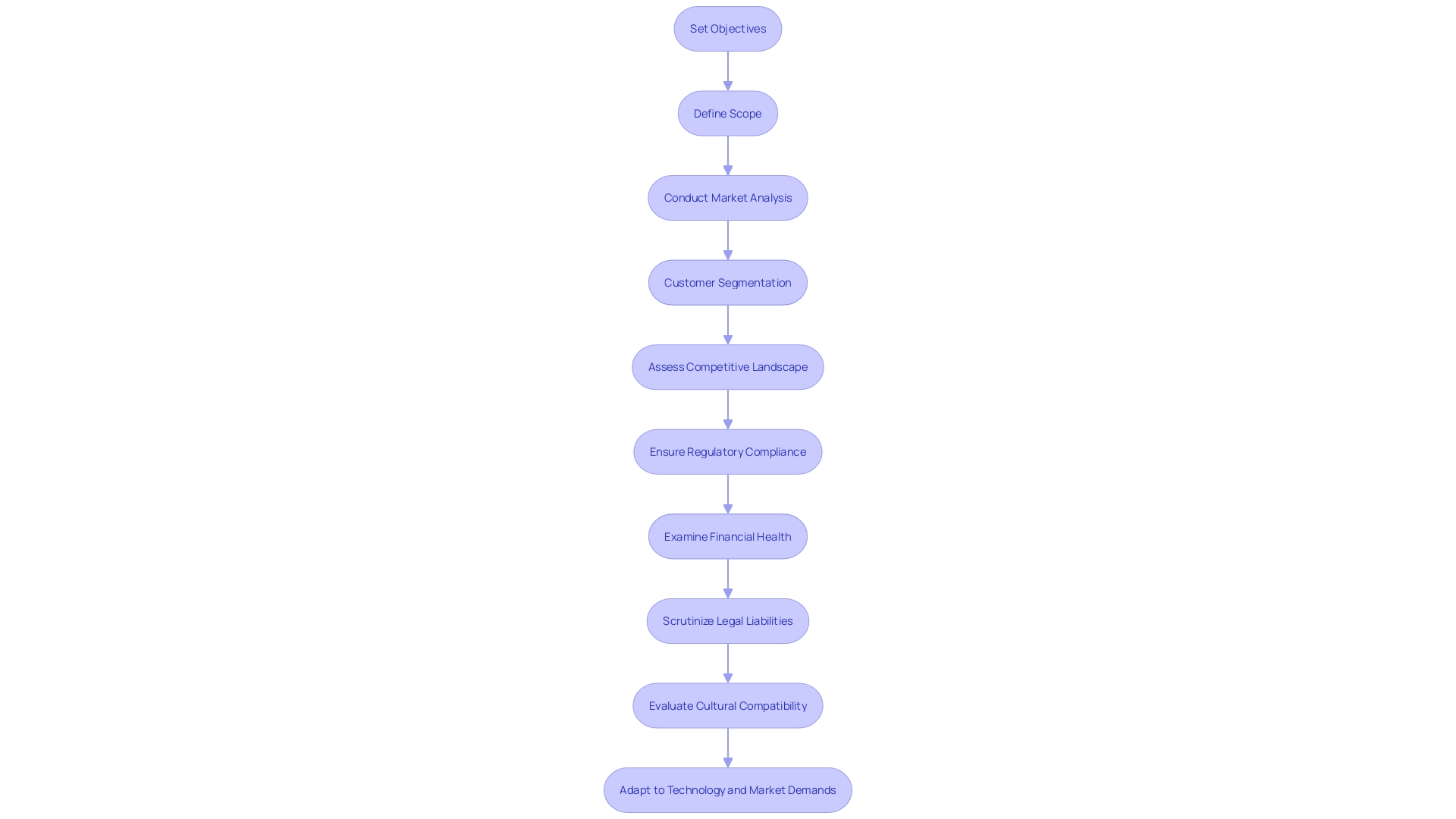
Gathering Data and Conducting Market Research
In a strategic move to enhance its competitive edge, Company X embarked on a meticulous data collection and market analysis endeavor. This process was crucial for understanding the intricate tapestry of the industry in which the target company operated. They delved into dissecting market trends, evaluating consumer preferences, scrutinizing the competitive landscape, and considering the impact of regulatory policies.
The approach was twofold: primary research methods, such as surveys, allowed for the acquisition of fresh, firsthand data directly from consumers, revealing their experiences and levels of satisfaction. Secondary research complemented this by offering insights from existing data sources, ensuring a well-rounded perspective. The fusion of these research methodologies empowered Company X with a deeper, more actionable intelligence, driving informed decision-making that could propel the company towards its strategic goals.
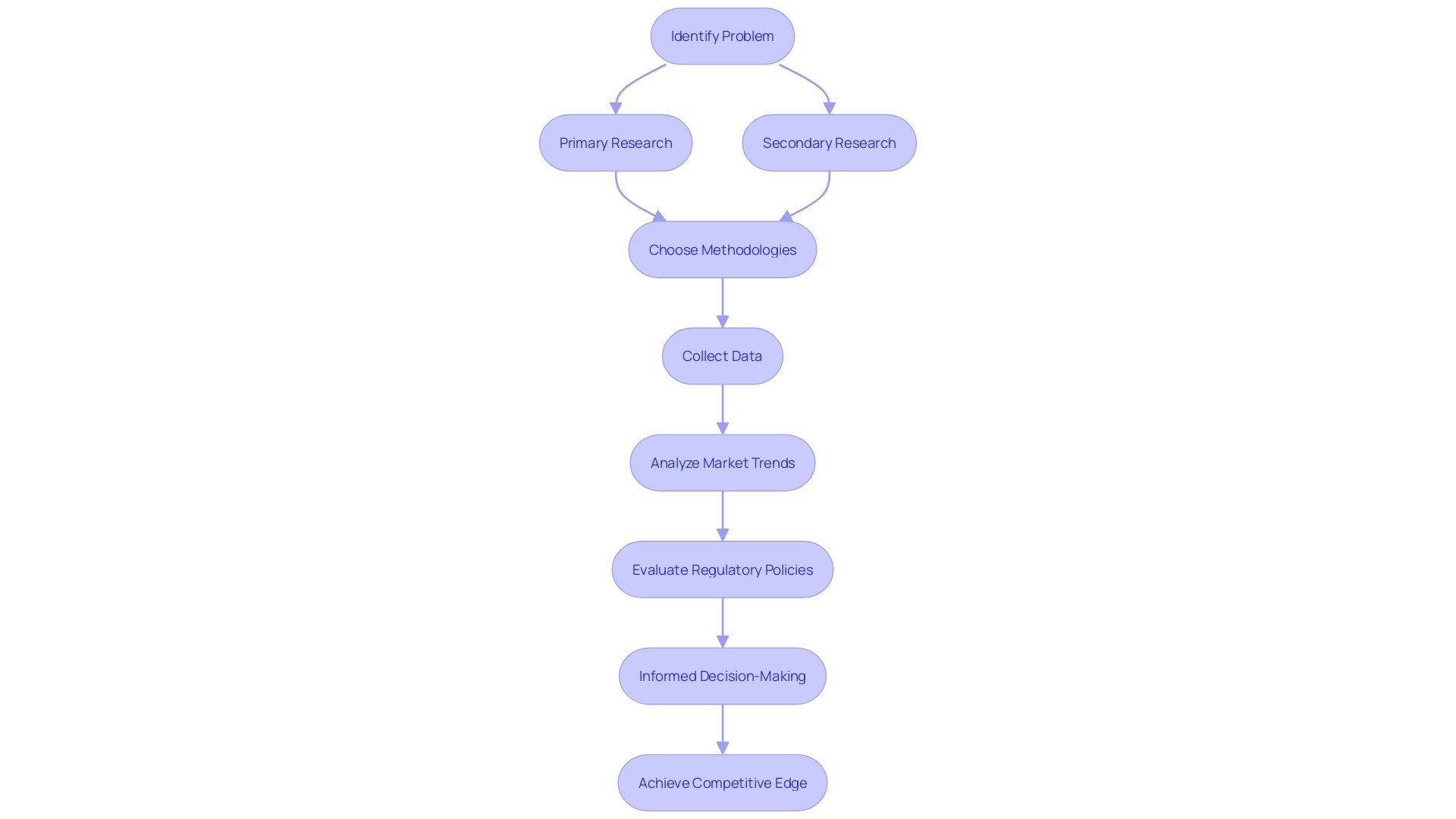
Assessing Financial Performance and Risks
The terrain of commercial due diligence is demanding, requiring a meticulous investigation of the target company's financial health and exposure to risk. When Company X initiated a comprehensive evaluation of another firm's financial records, it was akin to a surgeon meticulously dissecting the anatomy of a patient. They scrutinized revenue streams, profit margins, cash flow dynamics, and debt burdens with precision.
Their goal? To unearth hidden financial risks that might jeopardize the investment and to determine the robustness of the company's fiscal standing. In a landscape where a single oversight can lead to catastrophic consequences, such as those witnessed in California's wildfire crisis caused by utilities, or the financial turbulence faced by companies in the ever-evolving office real estate market, the importance of such due diligence cannot be overstated.
It echoes the sentiment expressed by Adrian Rahimi of Tricera Capital regarding the necessity for compelling reasons to make comeback strategies in sectors previously disrupted. This rigorous financial analysis is not merely about flagging potential hazards; it's about equipping investors with the foresight and knowledge to navigate through the unpredictable ebbs and flows of the business world, safeguarding assets, and steering towards the most profitable outcomes as suggested by the latest Heidrick & Struggles report.
Evaluating Operational Efficiency
In the realm of corporate acquisitions, the discernment of operational efficiency is pivotal for success. Company X embarked on a meticulous evaluation of their target's operational frameworks, scrutinizing supply chain management, production capacities, and cost structures. By pinpointing inefficiencies and recognizing areas ripe for synergy, Company X not only bolstered the operational performance but also significantly augmented the acquisition's overall value proposition.
In a similar vein, the strategic orchestration of data sourcing and vendor management is crucial. An adept sourcing team, by consistently securing the right data sets ahead of competitors, can capture market advantages. Yet, this is not solely the remit of the sourcing team; the entire process, from trial to compliance and onboarding, is essential to leverage these insights fully.
For instance, at Check Technologies, the Check Data Platform underpins data-informed decisions, enabling comprehensive analyses across various business functions. These range from evaluating marketing campaigns to monitoring fleet health. Such an integrated approach to data analysis is a testament to the potential gains from streamlining operations.
A case in point is Somerset Academies of Texas, where the introduction of integrated technology solutions by Austin Morgenroth, Director of Technology Services & Communications, transformed a fragmented software landscape into a cohesive ecosystem. This change not only streamlined processes but also bolstered operational efficiency across the board.
The current climate of mergers and acquisitions, as noted by industry experts, suggests a resurgence of activity. Companies are meticulously vetting not just their targets but themselves, ensuring alignment with long-term strategies. Successful acquisitions are often predicated on internal consensus on the acquisition's strategic fit and the preparedness to engage in post-diligence integration work.
For a company contemplating an acquisition, it is imperative to ponder several elements, such as the alignment with long-term vision, strategic milestones, and the resources at hand. Internal consensus is a cornerstone, as wavering on core objectives can undermine the potential of the acquisition. Moreover, having sufficient financial runway is critical, as corporate development strategies often involve pressuring the target to lower valuations due to time constraints.
Amidst these considerations, a recent survey indicated a shift towards greater selectiveness in deal pursuits, arguably due to a pronounced valuation gap between buyers and sellers. This gap has been identified as a primary impediment to M&A activity, affecting decisions on market entry for assets.
In summary, Company X's approach to enhancing operational efficiency demonstrates the strategic importance of thorough due diligence and post-acquisition integration. By focusing on process optimization and understanding the integral role of data management and technology, companies can better position themselves for successful acquisitions.
Benefits of Efficient Commercial Due Diligence
Navigating the complex landscape of mergers and acquisitions (M&A) requires a meticulous approach to commercial due diligence. Recent insights from EQT Corporation and Equitrans Midstream Corporation, both key players in the natural gas sector, underscore the vital role of operational efficiency and technology in this process. As the M&A climate experiences a 16 percent dip in global value, with a notable decrease in the number of companies changing hands, the imperative for a robust due diligence process is clear.
A comprehensive understanding of your company's enterprise value is indispensable. Critical factors like EBITDA, FCF, and revenue must be adjusted for accuracy to reflect your business's true financial health.
Delving into the Quality of Earnings (QOE) report is a strategic move that offers a granular look at your business's adjusted cash flow, providing a more nuanced perspective than traditional audits. In the words of industry leaders, achieving internal alignment on the objective and rationale behind an acquisition is paramount for strategic execution. Understanding the other party's position, beyond mere numbers, fosters a collaborative environment conducive to successful deal closure.
Moreover, the intricate nature of M&A contracts, as evidenced by a 21-year corpus of publicly disclosed agreements, signifies their criticality in financial markets. With organizations like White & Case delivering comprehensive data and analysis in antitrust and competition for global deals, the importance of staying informed and prepared is evident. Through strategic alignment, detailed financial analysis, and a thorough due diligence process, companies can navigate the complexities of M&A to achieve successful restructuring and long-term growth.
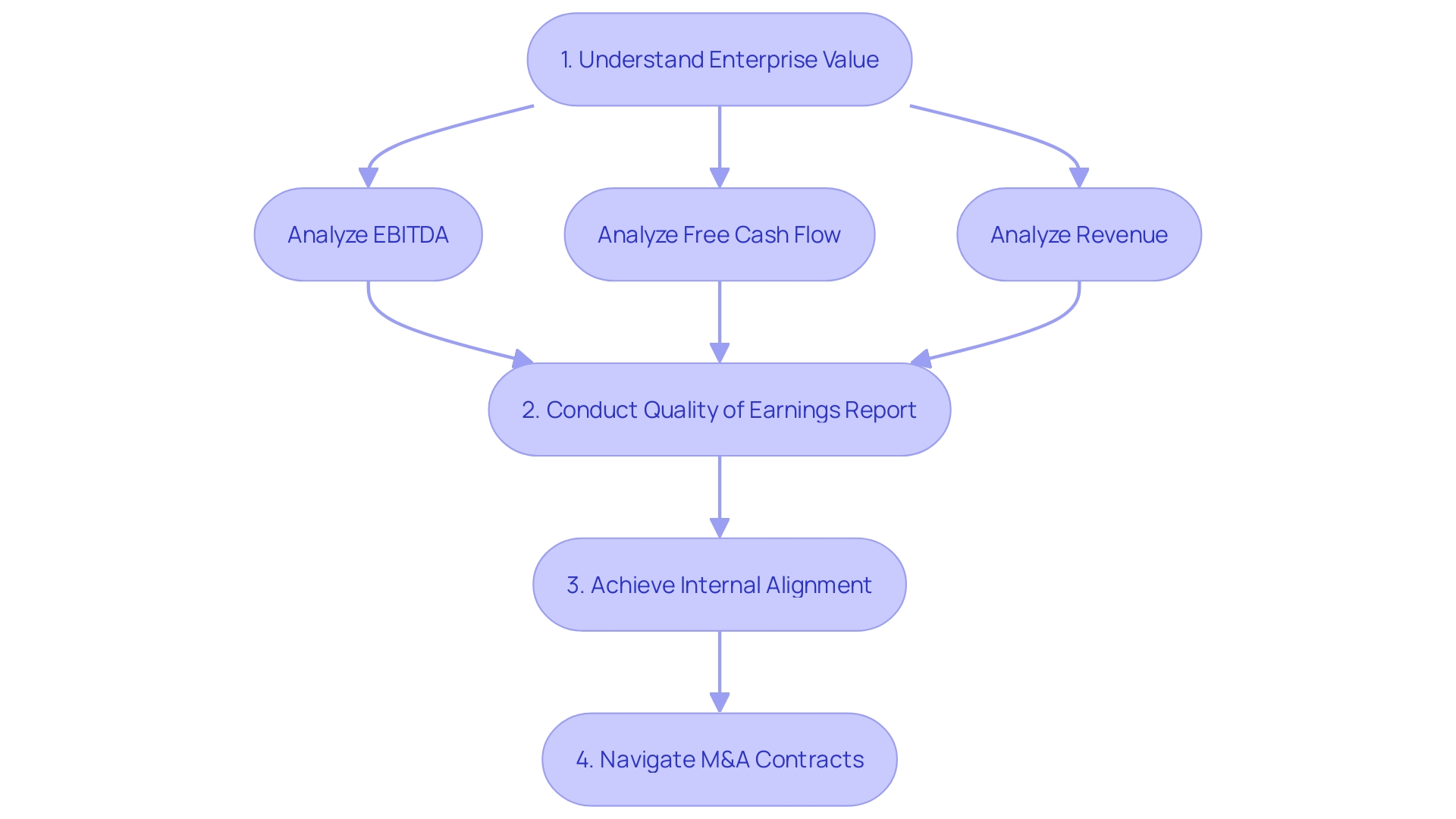
Minimized Risks and Informed Decision-Making
A meticulous due diligence process was pivotal to Company X's strategy in minimizing acquisition risks. They achieved a profound comprehension of the target company's capabilities and vulnerabilities, which was crucial for making informed decisions. This approach echoes the complexity encountered in sectors like utility companies dealing with catastrophic wildfire risks in California.
The uncertainty in risk levels and mitigation effectiveness in such industries necessitates a due diligence that transcends financial audits, covering regulatory compliance, IT infrastructure, and potential legal liabilities.
The acquisition landscape is complex, as highlighted by the dynamics between venture capitalists and corporate incentive structures. Company X's due diligence likely involved assessing if the target had experience in developing industry-specific software or hardware, had taken products through the clinical development process, or had launched products with a clear understanding of the industry's regulatory framework and stakeholder interactions.
Recent trends in mergers and acquisitions indicate a resurgence, with companies seeking to consolidate their market positions or drive expansion despite economic slowdowns. Successful acquisitions require a thorough understanding of both companies involved. Cultural compatibility, a key indicator of a successful merger, demands a deliberate communication strategy to integrate and leverage the strengths of both organizations.
In health care, for instance, consolidation has taken various forms, from horizontal mergers to 'soft' affiliations like accountable care organizations and joint ventures. These movements have reshaped provider markets significantly over the past three decades, suggesting that well-executed due diligence can be a game-changer in navigating the intricate M&A terrain.
Ultimately, the due diligence process is a catalyst for success, ensuring that companies like Company X are well-equipped to make strategic decisions that align with their business objectives and the intricate web of industry-specific challenges.
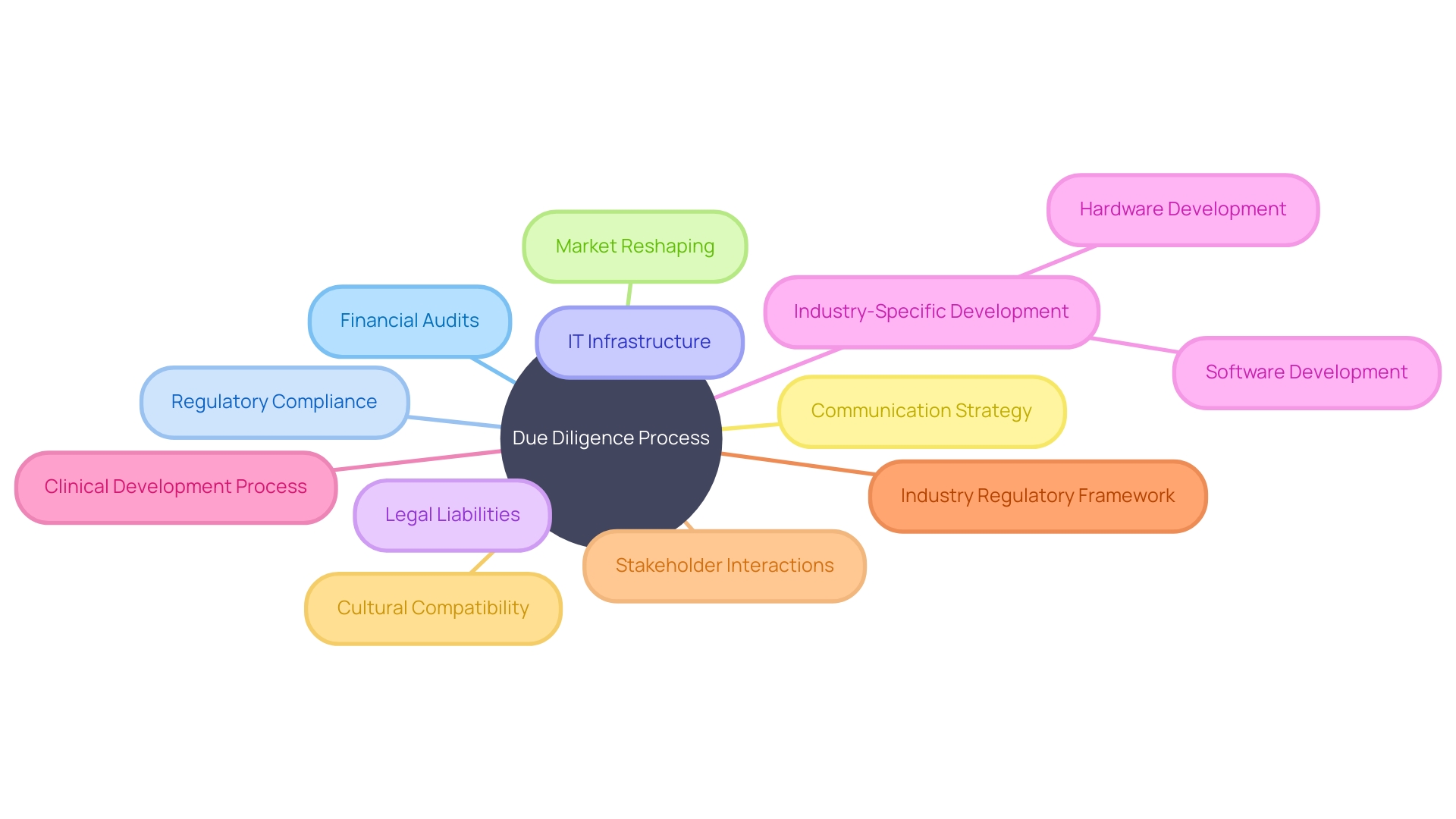
Enhanced Value Creation
To fortify its market position and ensure a prosperous future, Company X meticulously performed commercial due diligence, a critical step in their acquisition process. They rigorously evaluated the target's market standing, customer base, and operational prowess. This strategic analysis was not merely an assessment but an opportunity to ascertain key value drivers and potential areas for value creation, much like HCA Healthcare's involvement in a merger that culminated from a shared vision to revolutionize healthcare through cutting-edge software, sensors, and AI.
In the context of M&A, it's essential to note that the process diverges significantly from capital raising. The M&A landscape is complex and often unpredictable, as illustrated by the experience of Lemonaid Health. Despite offering a wide array of services in a burgeoning telehealth market, Lemonaid Health confronted challenges in market expansion due to a convoluted paid media strategy, underscoring the need for a nuanced approach to due diligence.
Company X’s approach echoes the sentiments of Justin Ishbia, "We have billion-dollar resources and knowledge and apply it to million-dollar companies." This philosophy guided them to unearth industry niches ripe for consolidation and to partner with top-tier executives, thereby leveraging their corporate machinery to catapult the acquired company to new heights.
Moreover, acquisitions are not merely transactions but strategic maneuvers often prompted by a company's need to address emerging market opportunities or threats swiftly. This is a sentiment shared by Haleon's demerger from GSK, a decision motivated by a desire to establish a robust presence in the consumer health sector while navigating the intricate process of a technology separation.
An MBA student in Finance and Sustainability aptly pointed out that a company's value drivers are pivotal to its success, emphasizing that they can range from quantifiable factors like revenue growth to qualitative aspects such as customer satisfaction. Company X recognized that by identifying and enhancing these drivers, they could significantly bolster their acquisition's value and performance.
The significance of due diligence in M&A cannot be overstated, as it is a forward-looking, principle-driven endeavor. It is akin to the 'Product Strength Index * Sales Capacity * Frictionless Process * TAM = Revenue' formula, which highlights the importance of a robust product, sales efficiency, seamless processes, and market potential in driving revenue growth—a principle that Company X embodied in their diligent acquisition strategy.
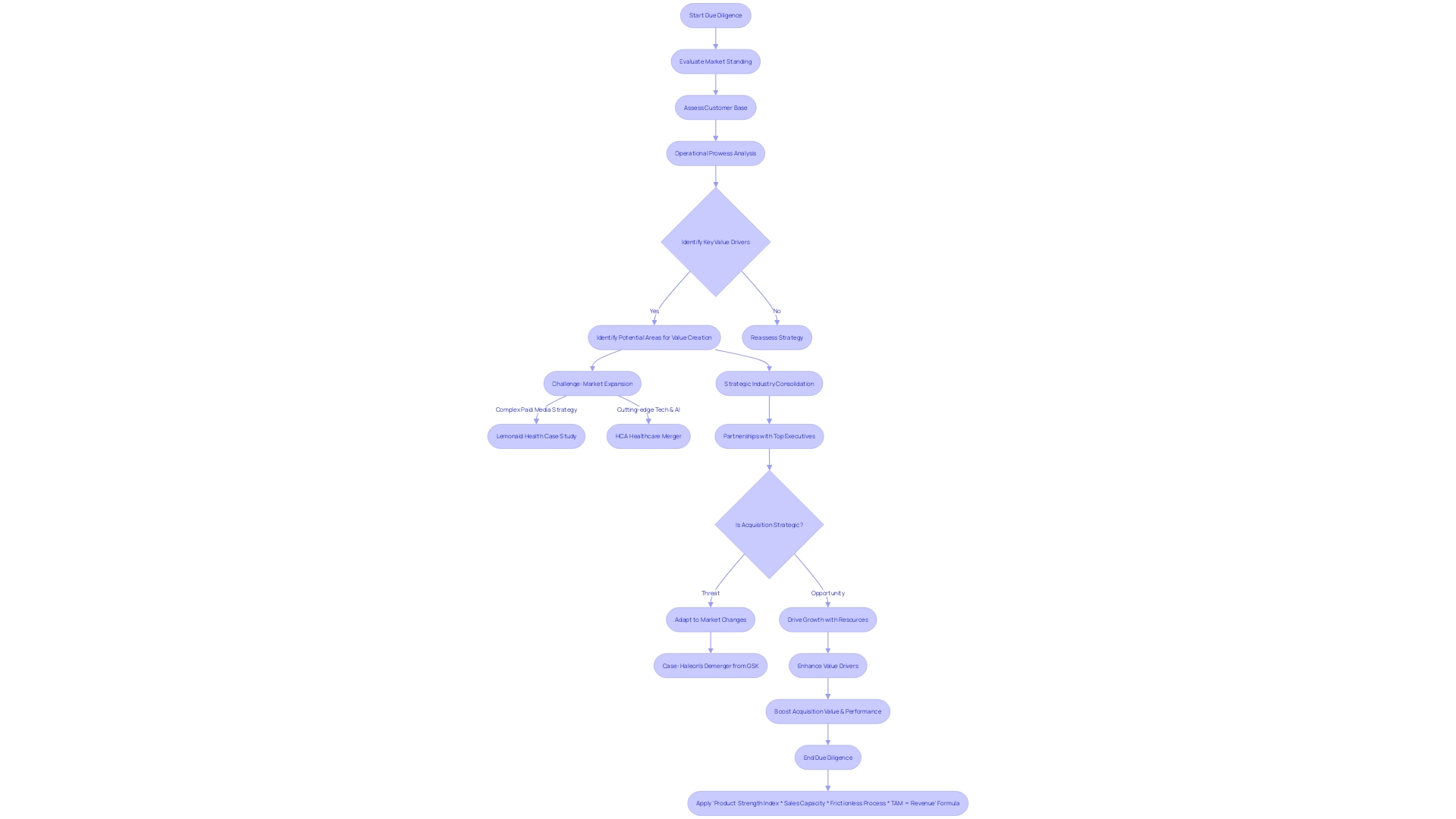
Common Challenges and How to Overcome Them
Commercial due diligence is an extensive process, involving more than just financial audits. It's a critical investigation into various aspects of a company— from environmental compliance to IT infrastructure. Yet, during this process, organizations often face significant challenges.
Company X, for example, grappled with issues like dispersed teams across multiple states, which is not uncommon. Teams from California to Michigan needed to collaborate effectively, despite the distance and specialization disparities.
To combat such challenges, companies can look to the example of Rivian, the electric vehicle manufacturer. Rivian's commitment to sustainability and net zero emissions by 2040 required them to streamline processes globally. They found that leveraging local talent and resources, while maintaining a high level of interdepartmental communication, helped them achieve more sustainable and faster processes.
Similarly, Cardinal Health's case study showcases the importance of a comprehensive regulatory strategy. A meticulous approach to due diligence led to timely and thorough investigational drug submissions, demonstrating the value of detailed legal and regulatory risk assessments.
The art market further illustrates the intricacies of due diligence, as seen with Shelby White's case. Facing the seizure of antiquities due to inadequate due diligence, it became clear that buyers must thoroughly vet transactions to avoid financial and legal repercussions. This speaks to the necessity of assessing a company's legal liabilities and compliance with tax laws.
Due diligence can yield remarkable results, as stated by industry leaders who have navigated uncertain markets and complex economic landscapes. It's about building resilience and a well-informed platform that can withstand varying expert opinions and market conditions.
Statistics from the Common Paper platform indicate that companies often negotiate Cloud Service Agreements (CSAs) with a 70% likelihood of choosing an annual subscription period and a 90% chance of automatic renewal. These insights reflect the need for due diligence in understanding and negotiating legal terms that govern vendor-customer relationships.
To overcome due diligence challenges, Company X and others should embrace a culture of change, similar to the shift towards incorporating alternative data in investment decision-making. This process can span years and involves overcoming siloed stakeholder resistance, as highlighted by the transition to new data types in the investment sector.
In summary, due diligence is a multifaceted process critical for identifying and addressing risks. It requires a comprehensive approach, from financial health to cybersecurity risks. Companies that successfully navigate this process can mitigate potential pitfalls and set themselves on a path to sustainable growth and compliance.
Limited Access to Data
In the intricate dance of due diligence, securing accurate and extensive data is pivotal. In a case involving the '648 patent, the challenge was amplified due to the sheer complexity and volume of information. Adopting an innovative approach, proprietary technology was utilized to synergize a patent knowledge base with AI capabilities.
This fusion allowed for the precise identification and programmatic analysis of documents crucial to patentability and infringement issues, setting a precedent for data gathering efficacy.
Similarly, the financial sector has grappled with data quality and credibility gaps. A report grounded in thorough interviews with investors highlights the importance of high-quality, independently assured data. The Product Strength Index (PSI) for financial instruments, which encompasses factors such as data history and collection consistency, serves as a metric for evaluating product robustness and market viability.
In the realm of market data, the Financial Conduct Authority (FCA) has identified barriers to entry and suppliers' commercial practices as areas of concern. The call for standardization echoes through the industry as a potential solution to fee disparities. Yet, the apprehension of price hikes looms over smaller entities, indicating a market in disarray.
Even in the construction sector, data-driven insights pave the way for strategic decisions. Dodge Data's case study on a building product manufacturer exemplifies the power of comprehensive market analysis, which includes understanding the competitive landscape and identifying growth opportunities.
This multifaceted approach, where relationships with management are fortified and external data sources are leveraged, is not just a tactic but a strategic necessity. It is a blueprint for navigating the complexities of due diligence, enabling informed decision-making that aligns with an organization's strategic vision and operational imperatives.
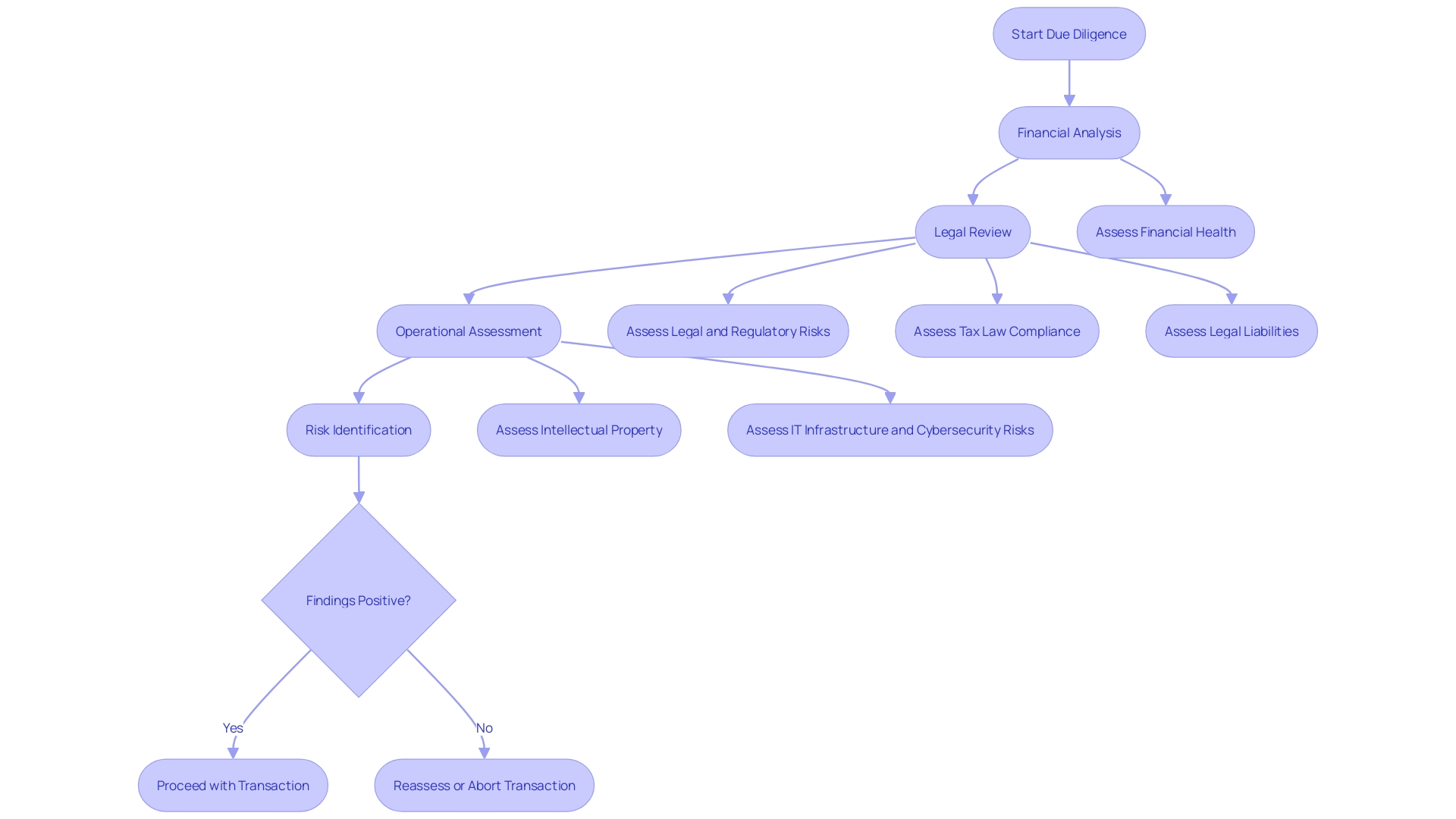
Time Constraints
To navigate the complexities of bankruptcy and restructuring, a meticulous due diligence process is crucial, yet time constraints often loom large. Company X faced such a challenge and chose to adopt a strategic approach. They established a structured timeline, akin to a critical path method, ensuring the most pressing and impactful areas received immediate attention.
This was complemented by a parallel analysis strategy, reminiscent of the approach used in effective data sourcing and procurement. For example, understanding the nuances of an options-based market required evaluating whether the underlying code was original or a modified fork, and identifying the primary functions used by customers.
Company X's method resonated with the scrappy and execution-focused mindset seen in the fast-paced talent acquisition sector, where timing can be a critical factor in success. By allocating resources adeptly and maintaining a relentless focus on execution, they streamlined their due diligence, akin to how new software has revolutionized money laundering detection—increasing effectiveness and efficiency.
In the changing landscape of IPOs and corporate finance, as seen with the expected turnaround in Hong Kong's IPO fundraising, companies like Company X understand that a well-structured due diligence process can significantly influence the outcome, much like timing in talent acquisition. Embracing this approach can help in identifying potential risks and opportunities that are essential for a successful restructuring process.
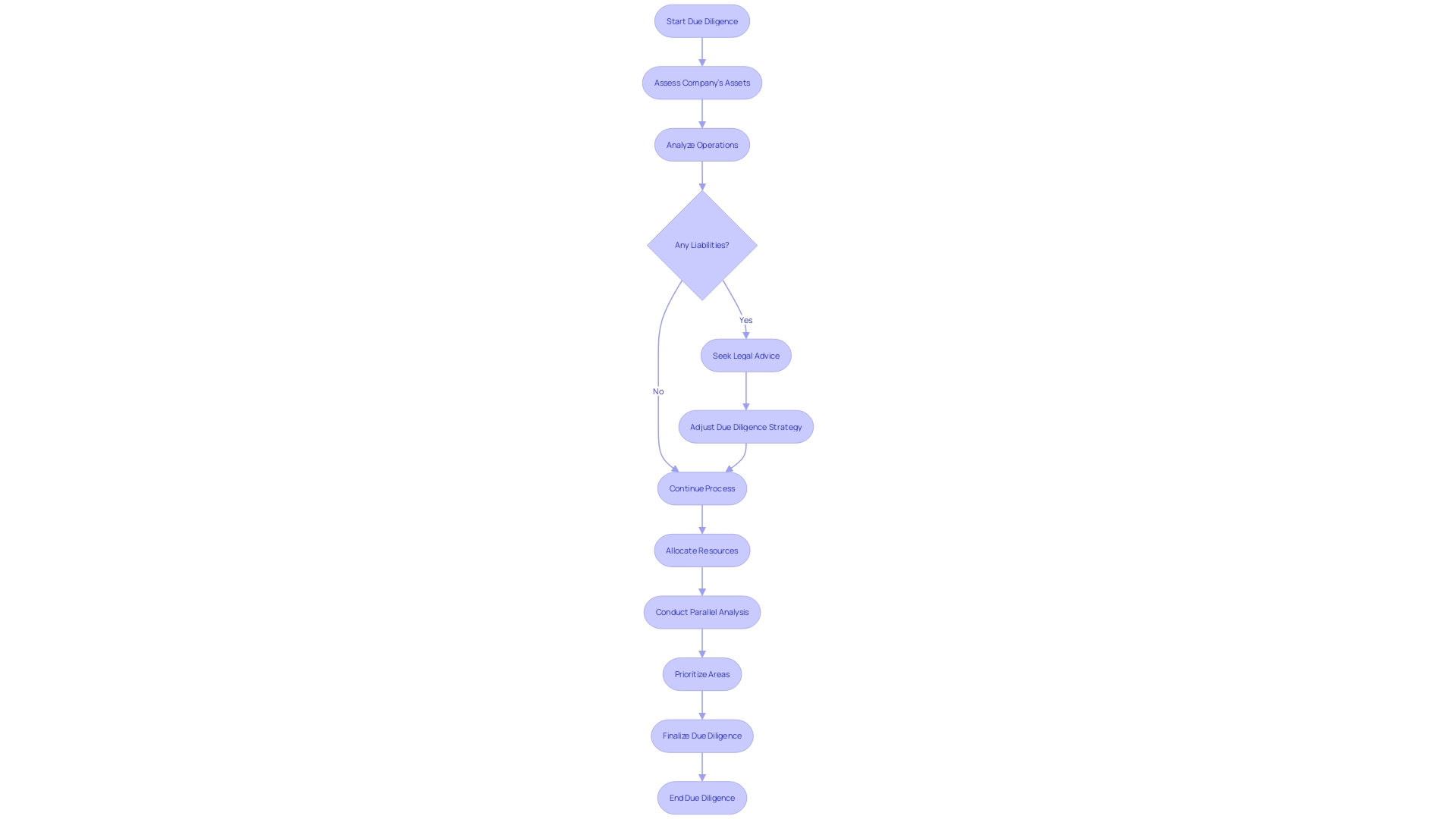
Best Practices for Maximizing Efficiency in Commercial Due Diligence
Drawing on the experience from Company X's successful approach, we delve into a series of best practices for optimizing commercial due diligence. To begin, an overarching examination of the project's structure is essential to discern the uniqueness of the code and identify the primary functions utilized by users. This forms the foundation for understanding both the operational intricacies and the market niche the company occupies.
Moreover, a comprehensive audit extends beyond financial scrutiny to encompass a multi-faceted investigation into various company aspects. This includes a rigorous evaluation of compliance with environmental regulations, an in-depth review of the IT infrastructure, and a thorough assessment of legal and regulatory risks—critical for industries under stringent oversight. As such, the due diligence process should encompass:
- A detailed analysis of financial statements, assets, debts, cash flow, and projections.
- An exhaustive examination of legal liabilities, including scrutinizing partnerships and licensing agreements.
- A meticulous review of tax law compliance through the investigation of tax returns, audits, and pertinent agreements.
- An investigation into intellectual property holdings, covering patents, copyrights, trademarks, and brand value.
- A risk assessment of IT infrastructure and cybersecurity measures.
In addition, these practices are underpinned by the latest governance standards set forth by recent regulatory changes, as outlined in Section 765 of the Dodd-Frank Act. These standards demand enhanced board independence, stakeholder consideration, and rigorous conflict of interest management. The new rules promote transparency and align incentives among owners and participants, establishing a new benchmark for due diligence in the modern financial landscape.
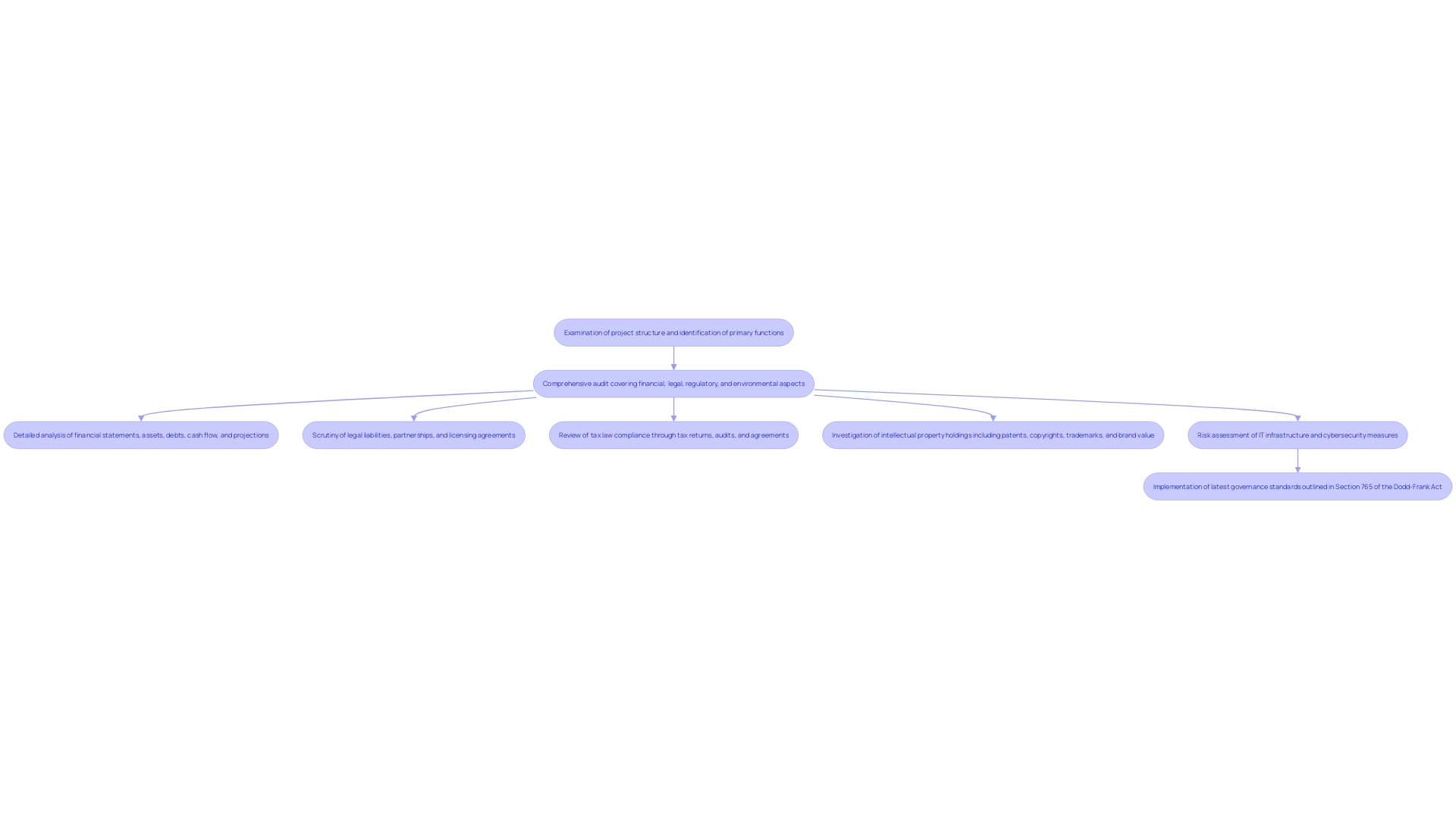
Establishing Clear Objectives and Scope
When embarking on due diligence, precision in setting objectives and defining the scope is vital, as it streamlines the process and allocates resources efficiently towards the most value-driven aspects. Due diligence transcends financial audits, delving into every facet of a business, including compliance with environmental laws and the robustness of IT systems. For instance, thorough evaluations of financials—scrutinizing statements, assets, liabilities, cash flows, and forward-looking projections—reveal the fiscal health of a target company.
Equally critical is the examination of legal and regulatory adherence, a non-negotiable in highly-regulated sectors, and tax compliance through a review of tax filings and historical audits. Understanding a company's legal entanglements, such as existing partnerships or licensing agreements, is also part of the comprehensive investigation. This holistic approach ensures that potential risks are identified and can be mitigated effectively.
The due diligence process is integral to strategic decision-making, whether considering market entry or product introduction. It begins with consensus-building on the objectives and rationale, aligning these with business priorities, and strategizing the most effective route to achieve them, be it in-house development or acquisition. For example, a business might align internally on pursuing an acquisition, outlining the potential structure and expectations.
This alignment is crucial to navigate the complexities of due diligence effectively and to ensure that the exercise is not just a procedural step but a strategic enabler for smart investments and successful restructuring.
Leveraging Technology and Data Analytics
The financial landscape is evolving with technology at its helm, offering tools that transform due diligence into a strategic asset rather than a mere checklist. At the forefront, data analytics emerges as a vital player in enhancing operational efficiency and informed decision-making. By integrating data visualization, predictive analytics, and automation, organizations like Boerse Stuttgart Group have navigated the complexities of the crypto market.
Their partnership with Chainalysis enabled them to delve deep into essential datasets, which fortified their AML stance and guided their strategic choices, from token listings to jurisdictional operations.
The necessity of such advanced technology is further underscored by the challenges in detecting financial statement fraud. With schemes growing in intricacy and data volumes surging, traditional methods falter. Advanced analytics and automation become indispensable in sifting through the complexities and safeguarding against concealed fraudulent activities.
The breadth of due diligence extends beyond financial audits, encompassing legal, regulatory, and IT infrastructural evaluations. The depth and reliability of data analytics, therefore, play a pivotal role in unearthing potential risks across various company facets. It's a transformative era where data informs action, and those equipped with cutting-edge analytical tools are positioned to make proactive, insightful decisions.
Amidst this evolution, one thing remains clear: the power of data analytics is not merely in its collection but in its conversion into actionable insights. As financial entities strive for a competitive advantage, the fusion of machine learning, AI, and blockchain with data analytics is not just a trend but a necessity for thriving in a data-driven financial milieu.

Collaboration and Cross-Functional Teams
In the complex terrain of commercial due diligence, it is paramount to amalgamate the expertise of diverse functional teams. This integration transforms the due diligence process into a comprehensive exercise, beyond the mere financial analysis. Take, for example, the approach adopted by Company X where finance, operations, legal, and strategy experts converge to form interdisciplinary teams.
Such a setup not only enhances the thoroughness of the analysis but also fortifies the decision-making process.
The success of this method is exemplified by scenarios where key stakeholders, such as joint venture partners or founders with significant rights, can dramatically influence the outcome of a transaction. Understanding their roles and planning strategically, as highlighted by M&A expert Christian Atzler, is crucial. This is akin to the domain-driven design (DDD) concept in software engineering, where large and complex domains are broken down into sub-domains, ensuring that each area is addressed by a specialized, cohesive unit.
This is not just theoretical; it is substantiated by the achievements of ventures like Antler, which thrives on the strategic unification of expertise, capital, and resourceful networks.
Furthermore, Grant’s insights on due diligence being a 'transformational' rather than 'adversarial' activity resonate here. It underscores the importance of a collaborative mindset, where cross-functional teams work in tandem to identify and capitalize on opportunities, thereby elevating the user experience through the simplification or rationalization of controls. This synergy is critical as it mirrors the broad spectrum of challenges and opportunities available in today's market landscape.
Statistics further emphasize the importance of cultural change within organizations as they integrate alternative data in their investment processes. A staggering 8 out of 10 firms face cultural hurdles as they attempt to break down silos and foster collaboration among stakeholders. This underpins the necessity for a cohesive approach to due diligence, ensuring that all relevant expertise is leveraged for a successful investment outcome.
The journey to integrate alternative data into investment decisions is arduous and can span years, yet it is a testament to the value of persistent, cross-functional team engagement.
In essence, the success of commercial due diligence in today's business environment hinges on effective collaboration across various functional domains, as evidenced by the experiences of companies and experts in the field.
Final Thoughts and Call to Action
The landscape of mergers and acquisitions is rife with complexities and the necessity for rigorous commercial due diligence cannot be overstated. As evidenced by Synopsys, Inc., a leader in electronic design, and Discover's expansion through acquisition to bolster its payments network, the insights garnered from a meticulous due diligence process are invaluable for ensuring that an M&A deal aligns with strategic goals and avoids pitfalls.
In a climate where economic and geopolitical turbulence has dampened the fervor for transactions, as reported by Al Barbarino, the role of due diligence becomes even more pronounced. It offers a comprehensive investigation into a prospective acquisition beyond mere financial health. It encompasses legal and regulatory risks, tax law compliance, environmental regulations, and IT infrastructure scrutiny.
As per the extensive research by White & Case, the intricate nature of M&A contracts underscores the urgency for such thorough vetting.
Proper alignment on the objectives of an acquisition is a precursor to success, as noted by industry leaders. It is essential to establish a consensus on the 'what' and 'why' before proceeding with a deal. This internal agreement should encompass long-term strategy, milestone timelines, and resource allocation to ensure a smooth post-merger integration.
Such preparation can transform the due diligence process from a backward-looking formality into a forward-planning tool, paving the way for a partnership that is beneficial for all parties involved and ensures the deal's fruition.
Conclusion
In conclusion, commercial due diligence is a multifaceted process that goes beyond financial audits to thoroughly examine the various aspects of a business. It involves assessing everything from environmental compliance and IT infrastructure integrity to legal and tax obligations. This comprehensive scrutiny enables investors to make well-informed decisions by identifying potential risks.
The process also involves evaluating market positioning, customer base, competitors, suppliers, and regulatory landscape to align investments with market opportunities.
Recent developments in commercial real estate and the current fundraising climate highlight the dynamic nature of due diligence and the need for professionals with in-depth knowledge. By meticulously following key steps such as data preparation, technology and product analysis, market positioning, assessment of legal and regulatory risks, and vision and impact evaluation, businesses can present a compelling case to investors.
Company X's successful approach to streamlining the due diligence process serves as a best practice for maximizing efficiency. Their focus on objectives, scope, leveraging technology, collaboration, and cross-functional teams demonstrates the importance of a structured and strategic approach. By aligning their due diligence efforts with their business goals, Company X was able to minimize risks, identify key value drivers, and enhance M&A efficiency.
Ultimately, commercial due diligence minimizes risks, enables informed decision-making, and enhances value creation in mergers and acquisitions. Navigating the complexities of due diligence requires a confident and action-oriented approach, incorporating practical advice and solutions. By following best practices, leveraging technology, fostering collaboration, and setting clear objectives, CFOs can ensure that their due diligence process is thorough, efficient, and aligned with their strategic goals.




